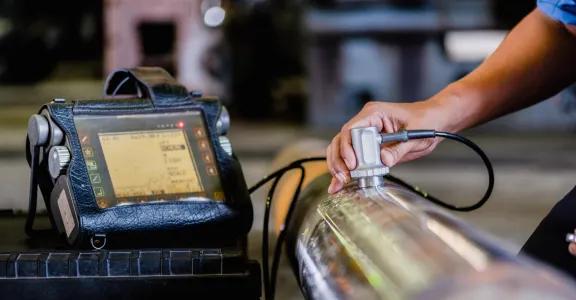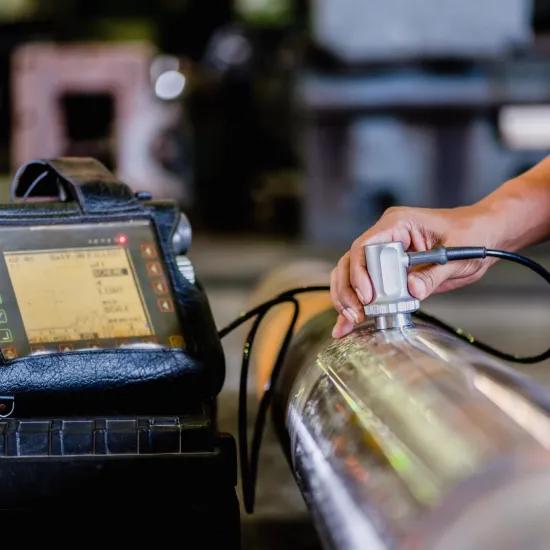Non-destructive techniques can be crucial for making optimal ReX (REX = remanufacture, refurbish, recondition, repurpose, ...) decisions.
Many sources can provide insights into the condition of products after their (initial) use. A previous blog offered inspiration and tips on how to assess this.
Chances are this will not give you enough information to make optimal decisions for a returned product. What is the actual degradation of the item in front of you? Which components are best replaced, which can be repaired, and which can be reused without any modifications? Ultimately, the goal is to offer ReX products that maintain high performance and quality while minimising risk, thereby upholding the esteemed reputation of your brand. Fortunately, there are a lot of non-destructive solutions and techniques you can use for this. Non-destructive, because you obviously don't want to cause any adverse impact/damage during the testing itself.
There are three types of non-destructive testing (NDT):
- Human inspection by an (experienced) operator
- Functional tests such as test benches
- NDT techniques based on measuring physical properties (typically using specific NDT equipment)
Which one you should use depends on the specific product and your context:
- What is the value and ReX margin for your product? In other words, what are the costs associated with testing, and how does the added value of testing compare to these costs? After all, deploying an operator, a test bench, or a non-destructive testing (NDT) device, all come with a certain cost.
- Material types and shape of your product. Some NDT techniques are only suitable for certain material types or geometries. For example, RX imaging will work well for metals but not for plastics.
- Which types of degradation are you aiming to identify, and where is the damage usually found: on the surface or beneath it? What are the probability and consequences of a specific degradation? If it is an infrequent form of degradation with minimal impact on safety and customer experience, for instance, you might decide against investing further resources and attention on it.
In practice, different methods and techniques are often combined in a ReX test plan with a flowchart adapted to the specific context. A basic principle is: ‘As simple as possible, as complex as necessary’. It is crucial to strike a balance between accuracy and efficiency. The cost and time for testing should be balanced against the benefits that each method offers, so that the process is both economical and effective.
Unfortunately, there is no ‘recipe’ or simple roadmap to create the optimal testing plan for your Rex context. Considering the numerous technical and economic factors involved, it's essential to develop a strategy suited to your specific circumstances. By applying common sense and a structured approach where you systematically gather insights and validate assumptions, along with targeted assistance from specialists, you are likely to achieve favourable outcomes. In this overview, we present the main types and techniques of NDT testing, which may inspire and guide you in crafting your plan.
Visual inspection
Visual inspection by an operator is the simplest and most common form of NDT. It involves visually inspecting the product for defects such as cracks, scratches or irregularities. The following considerations can help determine how and where to apply this method:
- Visually, inspections are primarily (or exclusively?) limited to the surface.
- Use tools such as magnifiers, endoscopes for internal surfaces, or cameras if necessary.
- Operators can also perform additional low-tech tests:
- Dimensional checks: measurements with calipers, jigs and Go/NoGo measurements. For complex pieces, consider using a fixture frame to support safe and optimal positioning of the product, allowing the operator to access all necessary measurement locations.
- Sound tests: the sound when slowly rotating a rotating product, or the sound of the strike of a hammer can give a good indication of the integrity of a product
- Smell test, such as smelling ‘burnt’ electronics
- A checklist or a fill-in inspection report can support, standardise and secure/log the inspection. Definitely consider digitising these. This enables the information to be integrated seamlessly into the ongoing ReX process, while also systematically creating a database—and thereby a consultable repository—of crucial knowledge about the degradation and ReX of your products.
- Visual inspection may seem simple, but make no mistake, it requires a lot of experience and knowledge on the subject. This can be managed through adequate training and the provision of support tools, documentation, checklists, and processes.
Test benches - functional testing
In test benches, products are set up and tested by making them fully or partially ‘operate’, involving movements and mechanical and/or electrical loading. This simulates various operational conditions that the products or components might face in actual applications.
This may include extreme temperatures, voltage fluctuations, mechanical stresses and environmental factors. Test benches are widely used in final inspection of complex products. They can also be usefully deployed in a ReX context. Measuring and analysing the important parameters and comparing them with expected values (e.g. from a descriptive model) can indeed teach you a lot not only about the correct functioning of a product or component but also about its degradation. A few examples and considerations:
- Functional testing of rotating products such as motors and transmissions combined with vibration and temperature measurement is used to gather information on correct alignment, balance, possible wear and tear.
- Mechatronic products can include software in addition to hardware. The controller of a machine typically includes a programmable PLC that controls the machine (actuators) based on feedback from sensors, input via communication interfaces (e.g. Ethernet, USB, RS-232, CAN bus) and control algorithms. A controller test bench will simulate/create a functional environment by sending predefined signals (test protocol) to the component and comparing the measured response with expected values . Often, such test systems also include data collection systems, a library of test protocols and automated test programmes, and an overarching test software.
NDT techniques
There are quite a few publications and books on NDT techniques and their application for quality control in new production . NDT technology is a subject area in itself. Selecting the most appropriate technique, translating it to the specific business context, and applying it on a day-to-day basis typically requires specialist knowledge.
Little information can be found on NDT techniques specifically in the context of ReX. The operating principles of the NDT techniques and their applicability remain the same. In a ReX context, we may want to detect other degradation mechanisms that are not addressed in new production. The variability and lot sizes of products and components will also tend to be different. Based on a literature review and a case study, we made an overview of the eight most applicable NDT techniques in a ReX context, with an indication of their application domains, their advantages and disadvantages, typical application domains and an indication of their cost: Overview NDT techniques. In addition, we also provide an overview of some more specialised techniques that can be used to detect and characterise specific degradations.
Depending on the situation (degree of contamination, type of degradation, NDT technology), it may or may not be necessary to clean the product or component first.
Automation and artificial intelligence
Sometimes, employing automation and artificial intelligence for NDT in a ReX context is beneficial. The feasibility of this approach depends on the volume and value of the components. Here are some practical examples and relevant literature:
- Applying ‘machine vision’ and ‘deep learning’ for the automated visual inspection of a component or product. For example, the algorithm can do a pass/fail or good/bad evaluation.
- Cobots, robots or manipulators can also be applied in the inspection process, for example by mounting the NDT sensors on a robotic arm
- NDT measurements can be entered into software typically developed for quality measurements. They can help interpret, visualise and integrate measurement results into the further digital information flow.
Conclusion
Non-destructive evaluation (NDE) of products and components can greatly enhance the efficiency of a ReX setup. Numerous high-performance NDT technologies are at your disposal. To choose and integrate the best technique for your specific context, consulting with specialists can be invaluable.
Remanufacturing: would it work for your business?Reuse, repair, upgrade ... Remanufacturing is just one of the possibilities. How can you be sure you are using the most appropriate strategy for your business? With the COOCK project 'CIRKEL - Remanufacturing as a lever for value creation in a circular manufacturing industry', supported by VLAIO, Sirris gives you the practical tools you need to mitigate the risks and increase the chances of success. This is how you can get started
|






